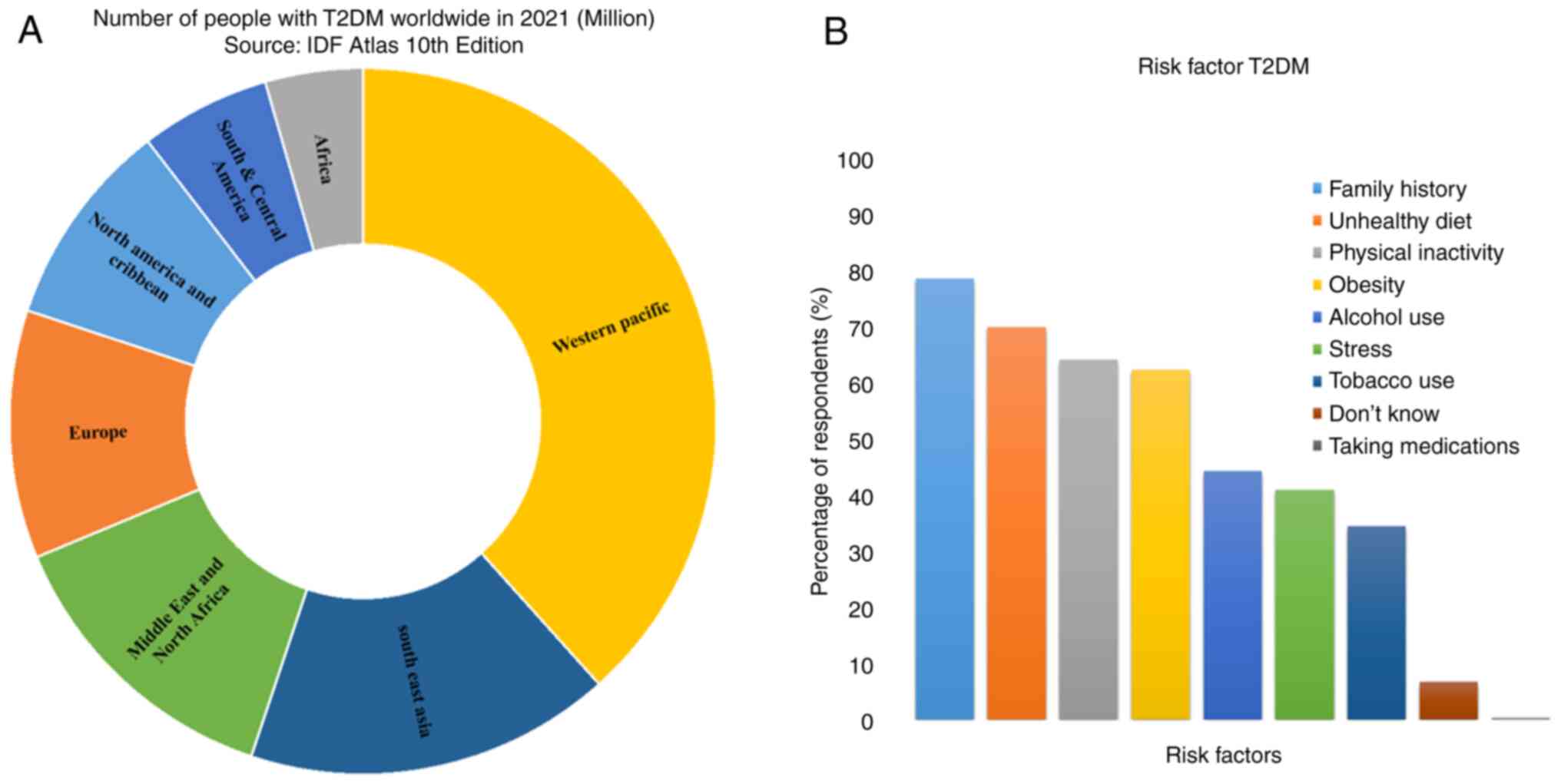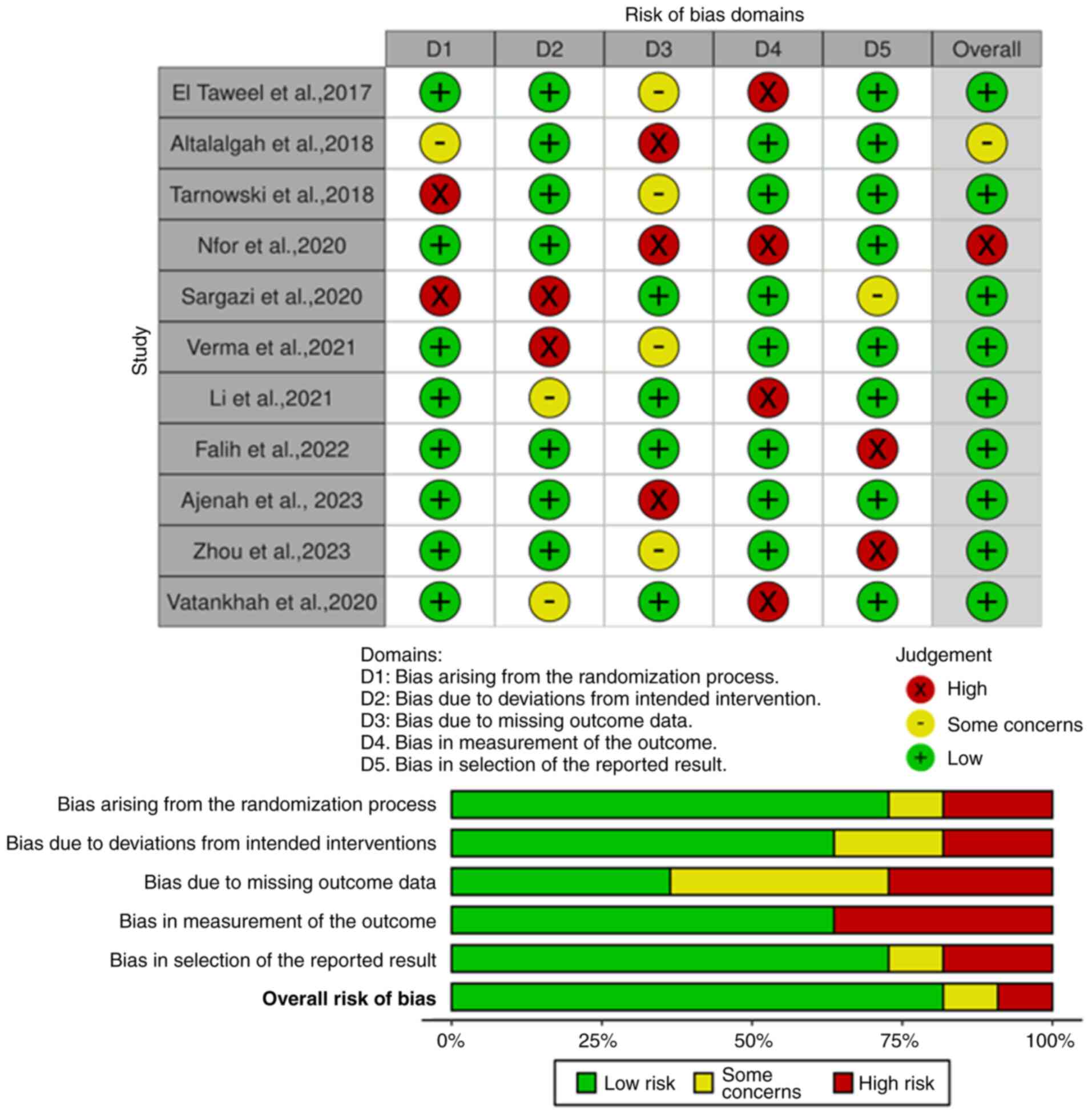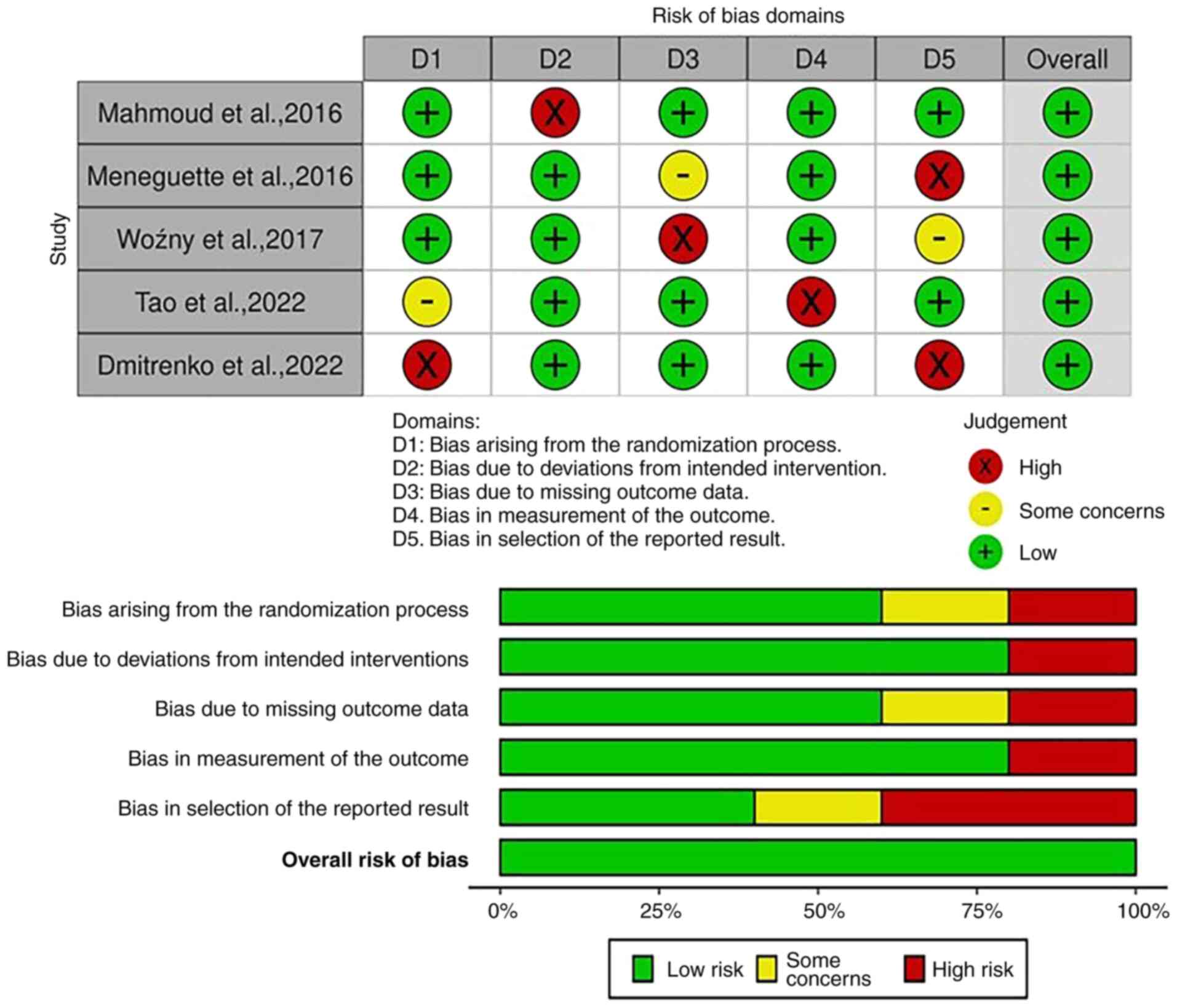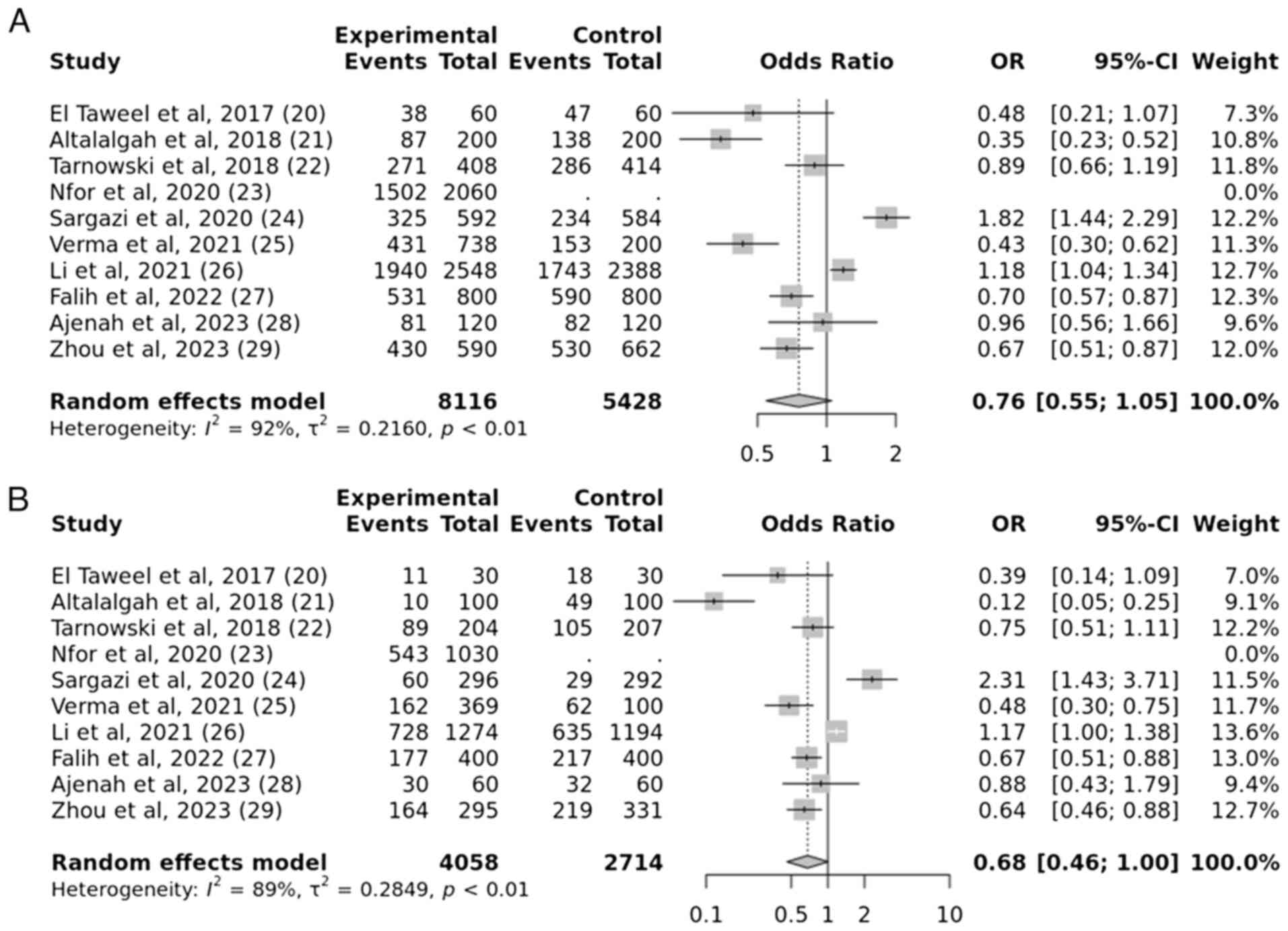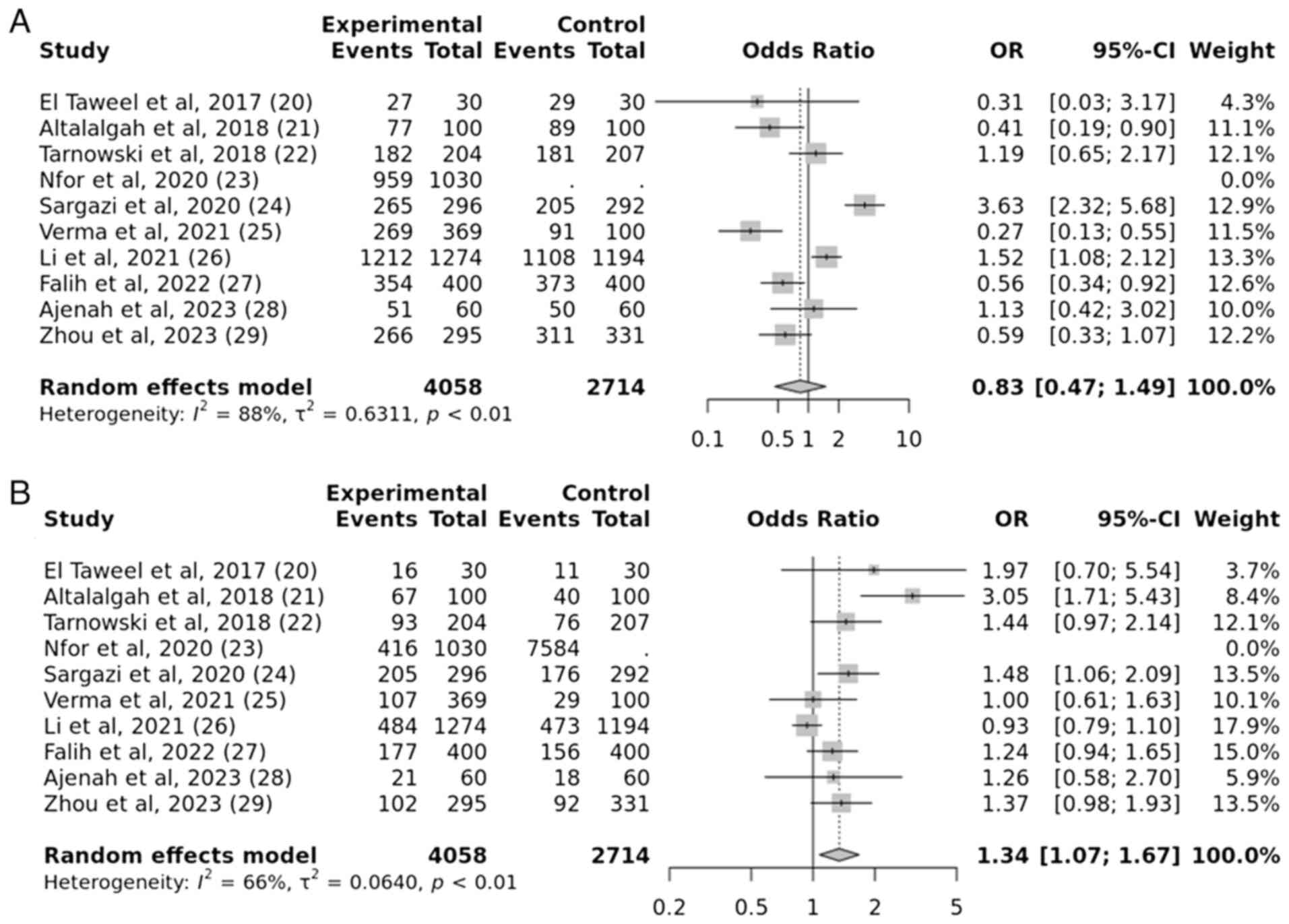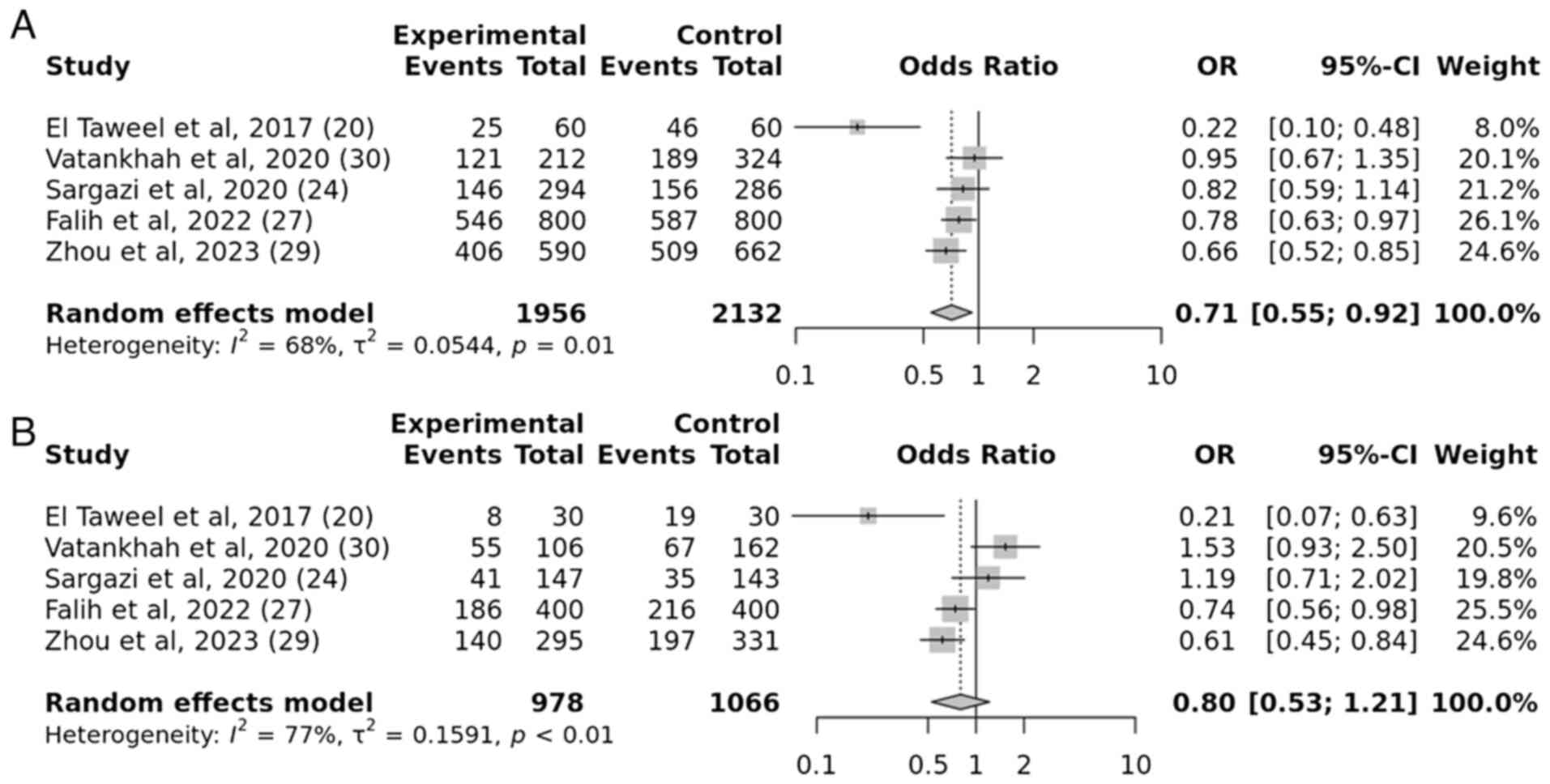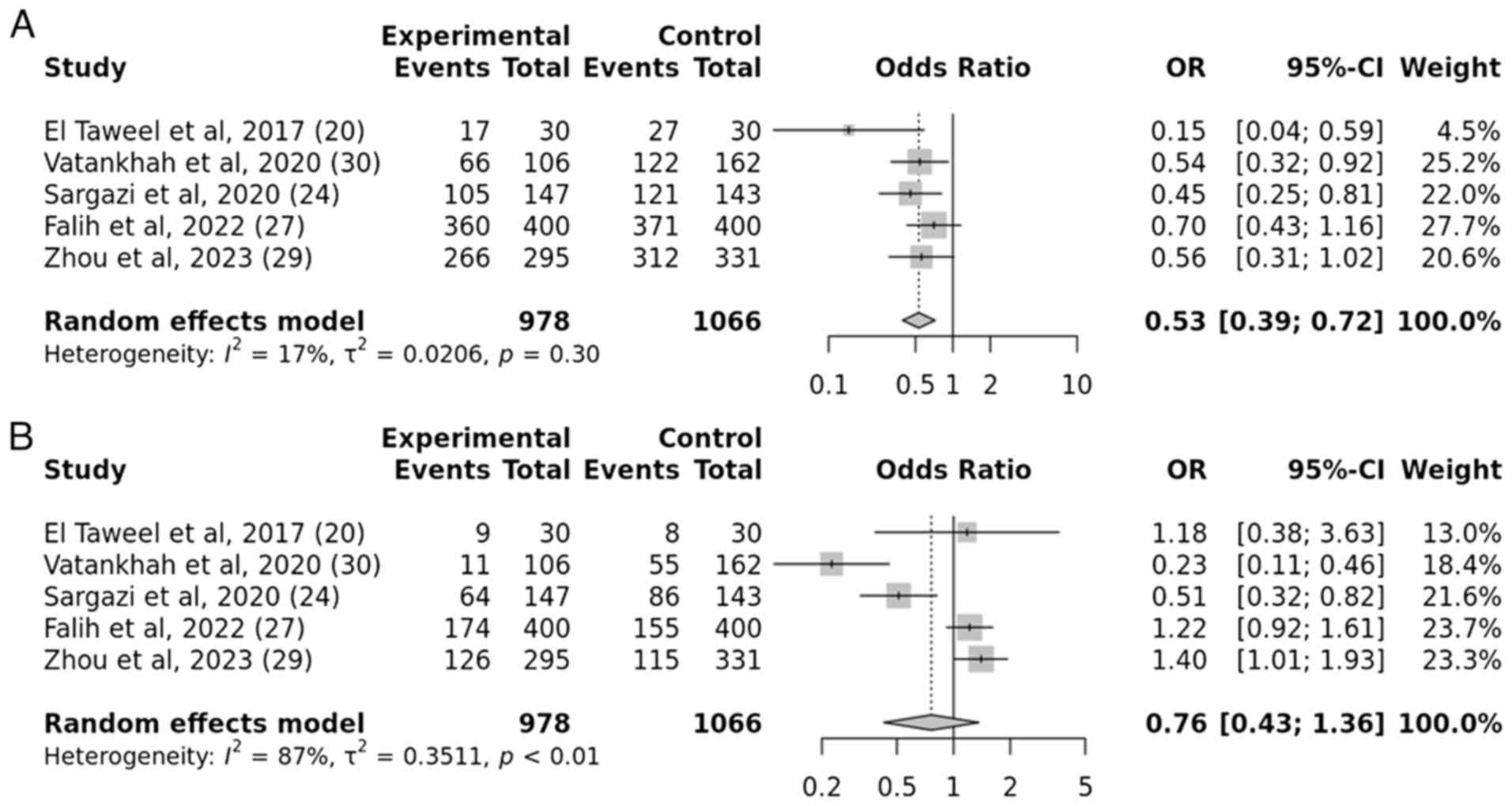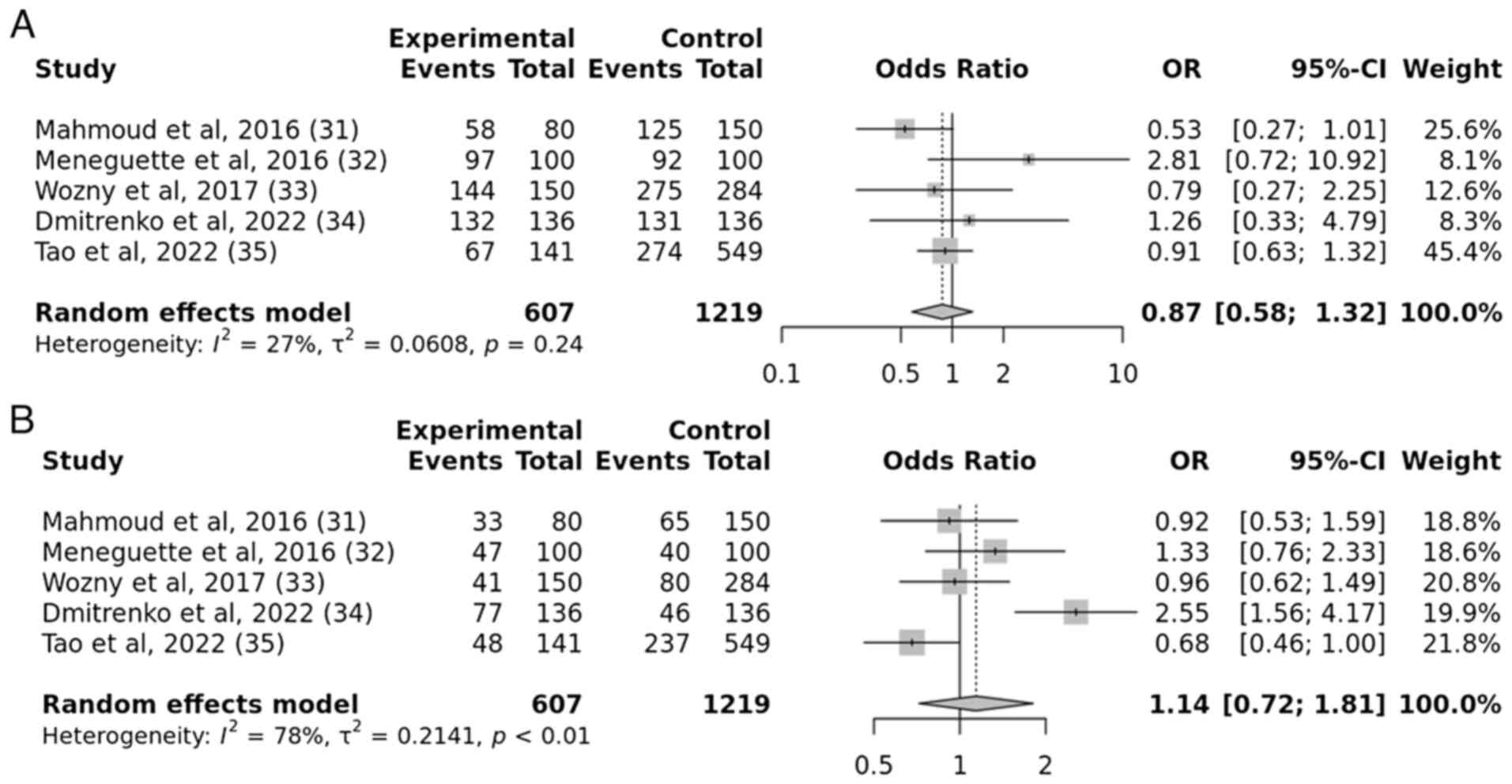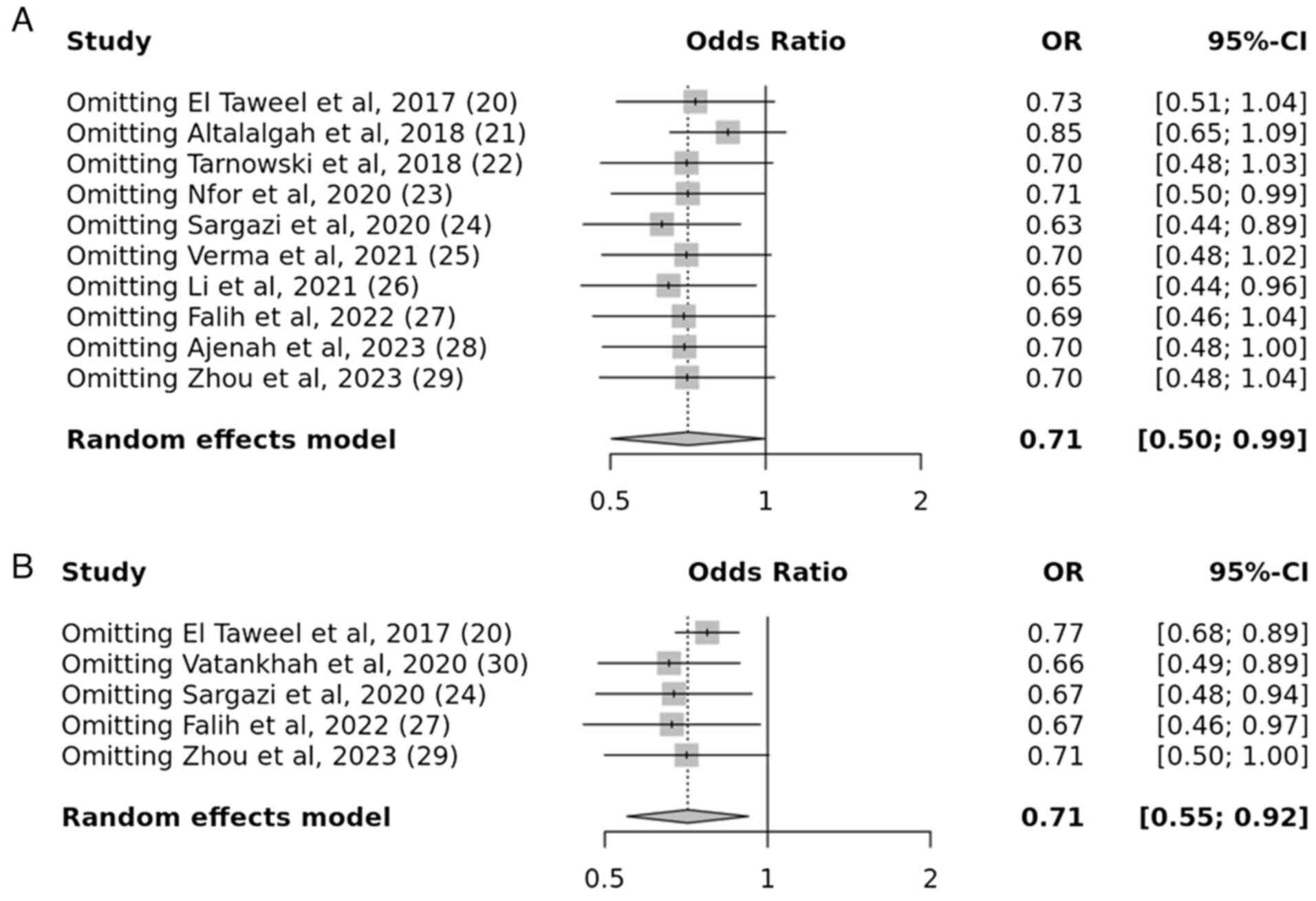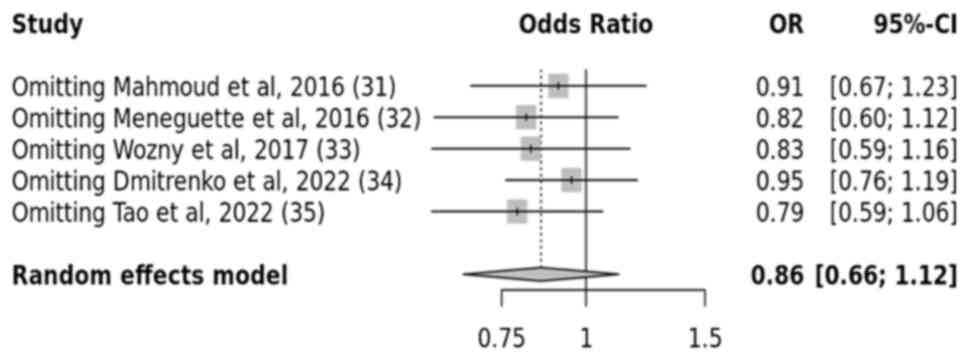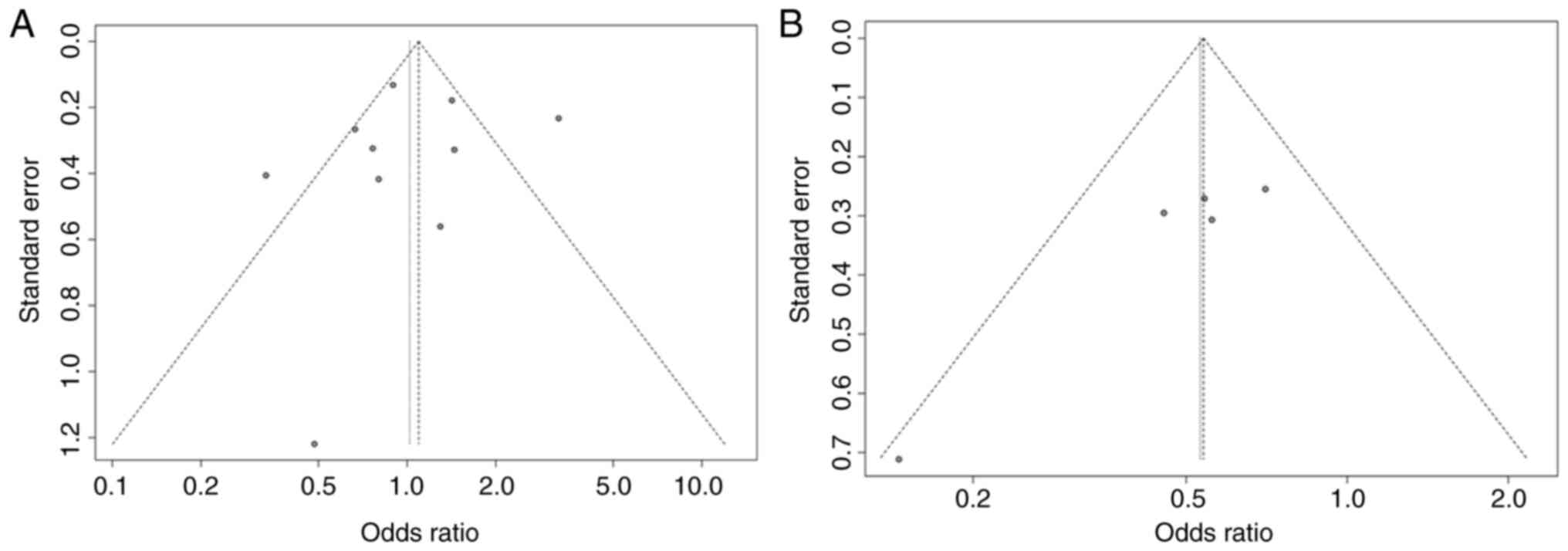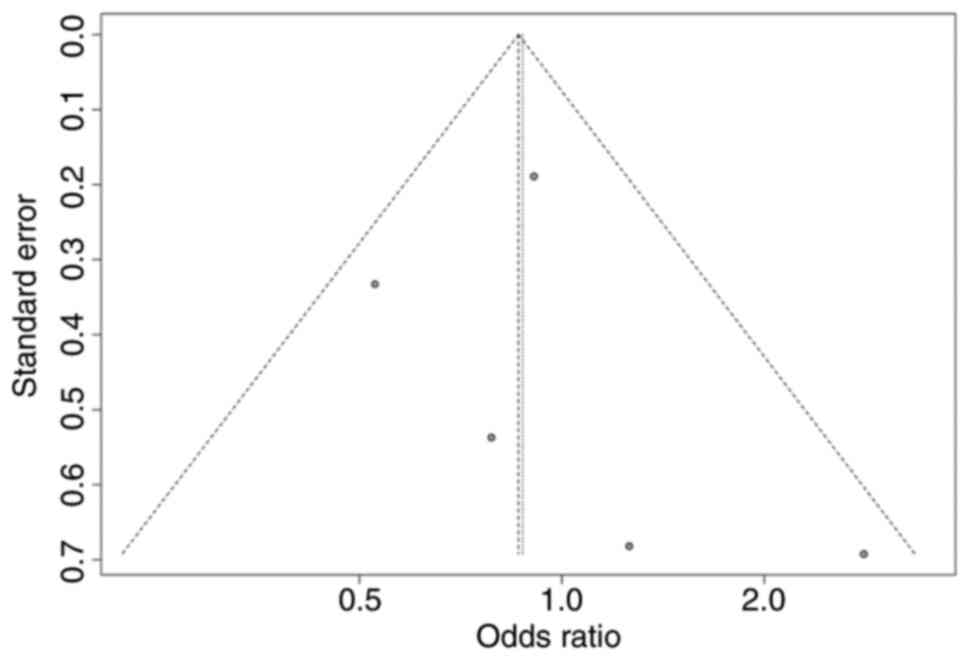|
1
|
Meng Y, Liu X, Ma K, Zhang L, Lu M, Zhao
M, Guan M-X and Qin G: Association of MTHFR C677T polymorphism and
type 2 diabetes mellitus (T2DM) susceptibility. Mol Genet Genomic
Med. 7(e1020)2019.PubMed/NCBI View Article : Google Scholar
|
|
2
|
World Health Organization The top 10
causes of death available from: http://www.who.int/en/news-room/fact-sheets/detail/the-top-10-causes-of-death
last accessed on 2021 Jun 04.
|
|
3
|
Pradeepa R and Mohan V: Epidemiology of
type 2 diabetes in India. Indian J Ophthalmol. 69:2932–2938.
2021.PubMed/NCBI View Article : Google Scholar
|
|
4
|
Golden SH, Yajnik C, Phatak S, Hanson R
and Knowler WC: Racial/ethnic differences in the burden of type 2
diabetes over the life course: A focus on the USA and India.
Diabetologia. 62:1751–1760. 2019.PubMed/NCBI View Article : Google Scholar
|
|
5
|
International Diabetes Federation IDF
Diabetes Atlas. 9th edition. International Diabetes Federation,
Belgium, 2019.
|
|
6
|
Magliano DJ, Boyko EJ and Atlas ID: What
is diabetes? In IDF Diabetes Atlas. 10th edition, 2021.
International diabetes federation. Available from: https://diabetesatlas.org/idfawp/resourcefiles/2021/07/IDF_Atlas_10th_Edition_2021.pdf.
|
|
7
|
Sathish T, Thankappan KR, Panniyammakal J
and Oldenburg B: Knowledge of diabetes among adults at high risk
for type 2 diabetes in the Trivandrum district of Kerala, India.
Diabetology. 4:76–85. 2023.
|
|
8
|
Galicia-Garcia U, Benito-Vicente A, Jebari
S, Larrea-Sebal A, Siddiqi H, Uribe KB, Ostolaza H and Martín C:
Pathophysiology of type 2 diabetes mellitus. Int J Mol Sci.
21(6275)2020.PubMed/NCBI View Article : Google Scholar
|
|
9
|
Roden M and Shulman GI: The integrative
biology of type 2 diabetes. Nature. 576:51–60. 2019.PubMed/NCBI View Article : Google Scholar
|
|
10
|
Kyrou I, Tsigos C, Mavrogianni C, Cardon
G, Van Stappen V, Latomme J, Kivelä J, Wikström K, Tsochev K,
Nanasi A, et al: Sociodemographic and lifestyle-related risk
factors for identifying vulnerable groups for type 2 diabetes: A
narrative review with emphasis on data from Europe. BMC Endocr
Disord. 20:1–3. 2020.PubMed/NCBI View Article : Google Scholar
|
|
11
|
Yahaya TO and Salisu TF: A review of type
2 diabetes mellitus predisposing genes. Curr Diabetes Rev.
16:52–61. 2020.PubMed/NCBI View Article : Google Scholar
|
|
12
|
Wu L, Zhang Y, Zhao H, Rong G, Huang P,
Wang F and Xu T: Dissecting the association of apolipoprotein E
gene polymorphisms with type 2 diabetes mellitus and coronary
artery disease. Front Endocrinol (Lausanne).
13(838547)2022.PubMed/NCBI View Article : Google Scholar
|
|
13
|
Zhao F, Wu L, Wang Q, Zhao X, Chen T, Yin
C, Yan L and Yang X: Insulin-like growth factor 2 mRNA-binding
protein 2-regulated alternative splicing of nuclear factor 1 C-type
causes excessive granulosa cell proliferation in polycystic ovary
syndrome. Cell Prolif. 55(e13216)2022.PubMed/NCBI View Article : Google Scholar
|
|
14
|
Witka BZ, Oktaviani DJ, Marcellino M,
Barliana MI and Abdulah R: Type 2 diabetes-associated genetic
polymorphisms as potential disease predictors. Diabetes Metab Syndr
Obes. 12:2689–2706. 2019.PubMed/NCBI View Article : Google Scholar
|
|
15
|
Berumen J, Orozco L, Betancourt-Cravioto
M, Gallardo H, Zulueta M, Mendizabal L, Simon L, Benuto RE,
Ramírez-Campos E, Marin M, et al: Influence of obesity, parental
history of diabetes, and genes in type 2 diabetes: A case-control
study. Sci Rep. 9(2748)2019.PubMed/NCBI View Article : Google Scholar
|
|
16
|
Wu QJ, Zhang TN, Chen HH, Yu XF, Lv JL,
Liu YY, Liu YS, Zheng G, Zhao JQ, Wei YF, et al: The Sirtuin family
in health and disease. Signal Transduct Target Ther.
7(402)2022.PubMed/NCBI View Article : Google Scholar
|
|
17
|
Khalil MM, Kasem HE and Genena SE:
Association of insulin receptor (INR) gene rs2252673 and Sirtuin1
rs7069102 polymorphisms with diabetic nephropathy in patients with
type 2 diabetes mellitus. Hum Gene. 33(201078)2022.
|
|
18
|
Ramirez A, Hernandez M, Suarez-Sanchez R,
Ortega C, Peralta J, Gomez J, Valladares A, Cruz M, Vázquez-Moreno
MA and Suárez-Sánchez F: Type 2 diabetes-associated polymorphisms
correlate with SIRT1 and TGF-β1 gene expression. Ann Hum
Genet. 84:185–194. 2020.
|
|
19
|
Li J, Yang Y, Xia Y, Luo S, Lin J, Xiao Y,
Li X, Huang G, Yang L, Xie Z and Zhou Z: Effect of SIRT1
gene single-nucleotide polymorphisms on susceptibility to type 1
diabetes in a Han Chinese population. J Endocrinol Invest.
47:819–826. 2024.PubMed/NCBI View Article : Google Scholar
|
|
20
|
El Taweel ME and Ali AA: Association of
the type 2 diabetes mellitus susceptibility gene (IGF2BP2)
with schizophrenia in an Egyptian sample. Middle East Curr
Psychiatry. 24:55–62. 2017.
|
|
21
|
Sharif FA, Shubair ME, Zaharna MM, Ashour
MJ, Altalalgah IO, Najjar M and Thalathini M: Genetic polymorphism
and risk of having type 2 diabetes in a Palestinian population: A
study of 16 gene polymorphisms. Insulin. 3:1–6. 2018.
|
|
22
|
Tarnowski M, Bujak J, Kopytko P, Majcher
S, Ustianowski P, Dziedziejko V, Safranow K and Pawlik A: Effect of
FTO and IGF2BP2 gene polymorphisms on duration of pregnancy
and Apgar scores in women with gestational diabetes. J Obstet
Gynaecol. 39:151–156. 2019.PubMed/NCBI View Article : Google Scholar
|
|
23
|
Nfor ON, Ndzinisa NB, Tsai MH, Hsiao CH
and Liaw YP: Interactive effect of IGF2BP2 rs4402960
variant, smoking, and type 2 diabetes. Diabetes Metab Syndr Obes.
13:5097–5102. 2020.PubMed/NCBI View Article : Google Scholar
|
|
24
|
Sargazi S, Nia MH, Saravani R, Shahroudi
MJ, Jahantigh D and Shakiba M: IGF2BP2 polymorphisms as
genetic biomarkers for either schizophrenia or type 2 diabetes
mellitus: A case-control study. Gene Rep. 20(100680)2020.
|
|
25
|
Verma AK, Goyal Y, Bhatt D, Beg MM, Dev K,
Alsahli MA and Rahmani AH: Association between CDKAL1, HHEX,
CDKN2A/2B and IGF2BP2 gene polymorphisms and susceptibility
to type 2 diabetes in Uttarakhand, India. Diabetes Metab Syndr
Obes. 14:23–36. 2021.PubMed/NCBI View Article : Google Scholar
|
|
26
|
Li Y, He S, Li C, Shen K, Yang M, Tao W,
Yang Y, Shi L and Yao Y: Evidence of association between
single-nucleotide polymorphisms in lipid metabolism-related genes
and type 2 diabetes mellitus in a Chinese population. Int J Med
Sci. 18(356)2021.PubMed/NCBI View Article : Google Scholar
|
|
27
|
Falih Z, Khodair BA, Mohammed NI and
Mohammed TK: Insulin-like growth factor-2 binding protein-2 gene
polymorphisms in Iraqi patients with type 2 diabetes mellitus. Open
Access Maced J Med Sci. 10:1178–1183. 2022.
|
|
28
|
Ajenah T, Al-Gazally ME and Bayati AA:
Lack of association between IGF2BP2 genes (rs4402960 and
rs11705701) polymorphism and type two diabetes mellitus. J Kufa
Chem Sci. 3:11–22. 2023.
|
|
29
|
Zhou W, Gao Q, He C, Wang L, Wang Y, Feng
L, Li W, Liu W, Ma R and Liu L: Association between polymorphism in
diabetes susceptibility gene insulin-like growth factor
2mRNA–binding protein 2 and risk of diffuse large B-cell lymphoma.
Clin Med Insights Oncol. 17(11795549231201128)2023.PubMed/NCBI View Article : Google Scholar
|
|
30
|
Vatankhah Yazdi K, Kalantar SM, Houshmand
M, Rahmanian M, Manaviat MR, Jahani MR, Kamalidehghan B and
Almasi-Hashiani A: SLC30A8, CDKAL1, TCF7L2, KCNQ1 and
IGF2BP2 are associated with type 2 diabetes mellitus in
Iranian patients. Diabetes Metab Syndr Obes. 13:897–906.
2020.PubMed/NCBI View Article : Google Scholar
|
|
31
|
Mahmoud AA, Moghazy HM and Ezat MA:
Association of sirtuin 1 gene single nucleotide polymorphisms with
type 2 diabetes mellitus in essential hypertension patients. Meta
Gene. 10:8–12. 2016.
|
|
32
|
Meneguette MV, Oliveira CA, Lima MH, Pina
KN and Amaral ME: Polymorphism in the SIRT1 gene and
parameters of metabolic syndrome in a sample of the adult Brazilian
population. Rev Nutr. 29:1–10. 2016.
|
|
33
|
Wozny L, Stefanowicz M, Danikiewicz M and
Grzeszczak W: The influence of rs2273773 and rs7895833 SIRT1
gene polymorphisms on life expectancy in context of metabolic
factors in Silesian population. Ann Acad Med Siles. 71:162–172.
2017.
|
|
34
|
Dmitrenko OP, Karpova NS and Nurbekov MK:
Association of polymorphisms rs1801282 of the PPARG gene, rs8192678
of the PPARGC1A gene and rs7895833 of the SIRT1 gene with
the risk of preeclampsia in pregnant women with gestational
diabetes in the Russian population. J Genet Genomic Sci.
7(2)2022.
|
|
35
|
Tao TT, Lin XH, Tang SJ, Gui WW, Zhu WF
and Li H: Association of genetic variants in the Sirt1 and
Nrf2 genes with the risk of metabolic syndrome in a Chinese
Han population. BMC Endocr Disord. 22(84)2022.PubMed/NCBI View Article : Google Scholar
|
|
36
|
Himanshu D, Ali W and Wamique M: Type 2
diabetes mellitus: pathogenesis and genetic diagnosis. J Diabetes
Metab Disord. 19:1959–1966. 2020.PubMed/NCBI View Article : Google Scholar
|
|
37
|
Xu X, Shen HR, Zhang JR and Li XL: The
role of insulin-like growth factor 2 mRNA binding proteins in
female reproductive pathophysiology. Reprod Biol Endocrinol.
20(89)2022.PubMed/NCBI View Article : Google Scholar
|
|
38
|
Cao J, Yan W, Ma X, Huang H and Yan H:
Insulin-like growth factor 2 mRNA-binding protein 2-A potential
link between type 2 diabetes mellitus and cancer. J Clin Endocrinol
Metab. 106:2807–2818. 2021.PubMed/NCBI View Article : Google Scholar
|
|
39
|
Trinh I, Gluscencova OB and Boulianne GL:
An in vivo screen for neuronal genes involved in obesity identifies
Diacylglycerol kinase as a regulator of insulin secretion. Mol
Metab. 19:13–23. 2019.PubMed/NCBI View Article : Google Scholar
|
|
40
|
Ali W, Sharaf SAE, Hamid EO and Ali AT:
Association of common variants in the IGF2BP2 gene with type
2 diabetes. Sohag Med J. 25:62–69. 2021.
|
|
41
|
Huang Z, Dong M, Li J, Qiu W and Li S:
Meta-analysis of the association of IGF2BP2 gene rs4402960
polymorphisms with T2DM in Asia. BIO Web Conf. 8(02003)2017.
|
|
42
|
Rao P, Wang H, Fang H, Gao Q, Zhang J,
Song M, Zhou Y, Wang Y and Wang W: Association between
IGF2BP2 polymorphisms and type 2 diabetes mellitus: a
case-control study and meta-analysis. Int J Environ Res Public
Health. 13(574)2016.PubMed/NCBI View Article : Google Scholar
|
|
43
|
Askin L, Tibilli H, Tanriverdi O and
Turkmen S: The relationship between coronary artery disease and
SIRT1 protein. North Clin Istanb. 7:631–635. 2020.PubMed/NCBI View Article : Google Scholar
|
|
44
|
Alam F, Syed H, Amjad S, Baig M, Khan TA
and Rehman R: Interplay between oxidative stress, SIRT1,
reproductive and metabolic functions. Curr Res Physiol. 4:119–124.
2021.PubMed/NCBI View Article : Google Scholar
|
|
45
|
Sadeghi MB, Nakhaee A, Saravani R, Sadeghi
MH, Sargazi S and Nia MH: SIRT1 functional polymorphisms
(rs12778366, rs3758391) as genetic biomarkers of susceptibility to
type 2 diabetes mellitus in Iranians: A case-control study and
computational analysis. Int J Diabetes Dev Ctries. 41:447–455.
2021.
|
|
46
|
Kaabi YA, Abdelmola AA, Abdelwahab SI,
Alshaikh NA, Halawi MA and Kuriri HM: Common genetic variants in
SIRT1 gene promoter and type 2 diabetes mellitus in Saudi
Arabia. Clin Lab: Feb 1, 2024 (Epub ahead of print).
|
|
47
|
Mohammed NI, Alzubaidi ZF and Khudhair M:
The relevance of rs6777038 and rs6444082 of IGF2BP2 gene
polymorphism and type 2 diabetes mellitus: A case control study.
Wiad Lek. 75:2811–2816. 2022.PubMed/NCBI View Article : Google Scholar
|
|
48
|
Liu J, Song G, Zhao G and Meng T: Lack of
association between IGF2BP2 rs4402960 polymorphism and gestational
diabetes mellitus: A case-control study, meta-analysis and trial
sequential analysis. Biosci Rep. 40(BSR20200990)2020.PubMed/NCBI View Article : Google Scholar
|
|
49
|
Li W, She L, Zhang M, Yang M, Zheng W, He
H, Wang P, Dai Q and Gong Z: The associations of IGF2, IGF2R and
IGF2BP2 gene polymorphisms with gestational diabetes mellitus: A
case-control study. PLoS One. 19(e0298063)2024.PubMed/NCBI View Article : Google Scholar
|
|
50
|
Zhu Z, Zhang Y, Bai R, Yang R, Shan Z, Ma
C, Yang J and Sun D: Association of genetic polymorphisms in
microRNAs with type 2 diabetes mellitus in a Chinese population.
Front Endocrinol (Lausanne). 11(587561)2021.PubMed/NCBI View Article : Google Scholar
|
|
51
|
Pang S, Zhang Z, Zhou Y, Zhang J and Yan
B: Genetic variants of SIRT1 gene promoter in type 2
diabetes. Int J Endocrinol. 2023(6919275)2023.PubMed/NCBI View Article : Google Scholar
|
|
52
|
Letonja J, Završnik M, Makuc J, Šeruga M,
Peterlin A, Cilenšek I and Petrovič D: Sirtuin 1 rs7069102
polymorphism is associated with diabetic nephropathy in patients
with type 2 diabetes mellitus. Bosn J Basic Med Sci. 21:642–646.
2021.PubMed/NCBI View Article : Google Scholar
|
|
53
|
Li J, Yang Y, Xia Y, Luo S, Lin J, Xiao Y,
Li X, Huang G, Yang L, Xie Z and Zhou Z: Effect of SIRT1 gene
single-nucleotide polymorphisms on susceptibility to type 1
diabetes in a Han Chinese population. J Endocrinol Invest.
47:819–826. 2024.PubMed/NCBI View Article : Google Scholar
|
|
54
|
Deeksha C, Kumar SG, Sangeeta S, Kumar SS
and Kaleem AM: Unraveling epigenetic signatures for early detection
of diabetes nephropathy in type 2 diabetes: A case-control
investigation. Biomed Biotechnol Res J. 8:108–116. 2024.
|
|
55
|
Canto-Cetina T, Silva-Nicanor D,
Coral-Vázquez RM, Cano-Martínez LJ and Canto P: RS3480 polymorphism
of FNDC5/Irisin is associated with type 2 diabetes mellitus
in Maya-Mestizo women. Metab Syndr Relat Disord. 21:503–508.
2023.PubMed/NCBI View Article : Google Scholar
|
|
56
|
Atere AD, Chukwuemeka CE, Oluwatuyi KO and
Olupeka BT: Serum amyloid A as acute phase protein and its
association with dyslipidemia in type 2 diabetes. Biomed Biotechnol
Res J. 7:195–200. 2023.
|
|
57
|
Huang T, Wang L, Bai M, Zheng J, Yuan D,
He Y, Wang Y, Jin T and Cui W: Influence of IGF2BP2, HMG20A, and
HNF1B genetic polymorphisms on the susceptibility to type 2
diabetes mellitus in Chinese Han population. Biosci Rep.
40(BSR20193955)2020.PubMed/NCBI View Article : Google Scholar
|



